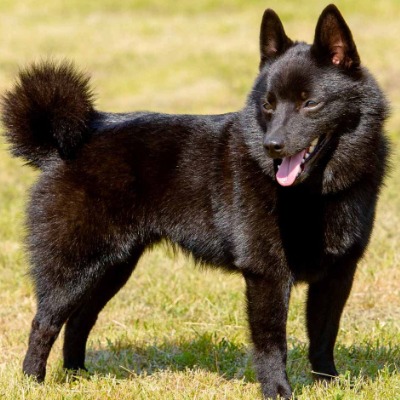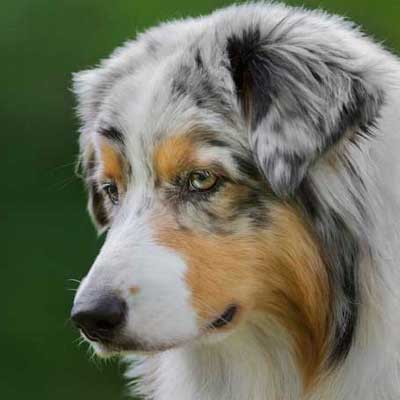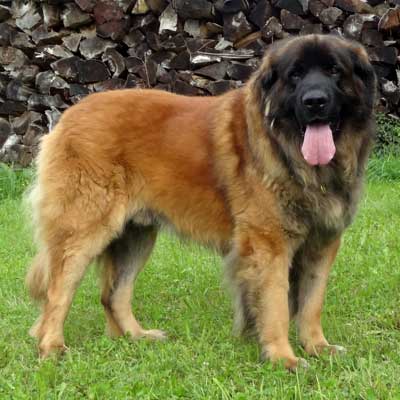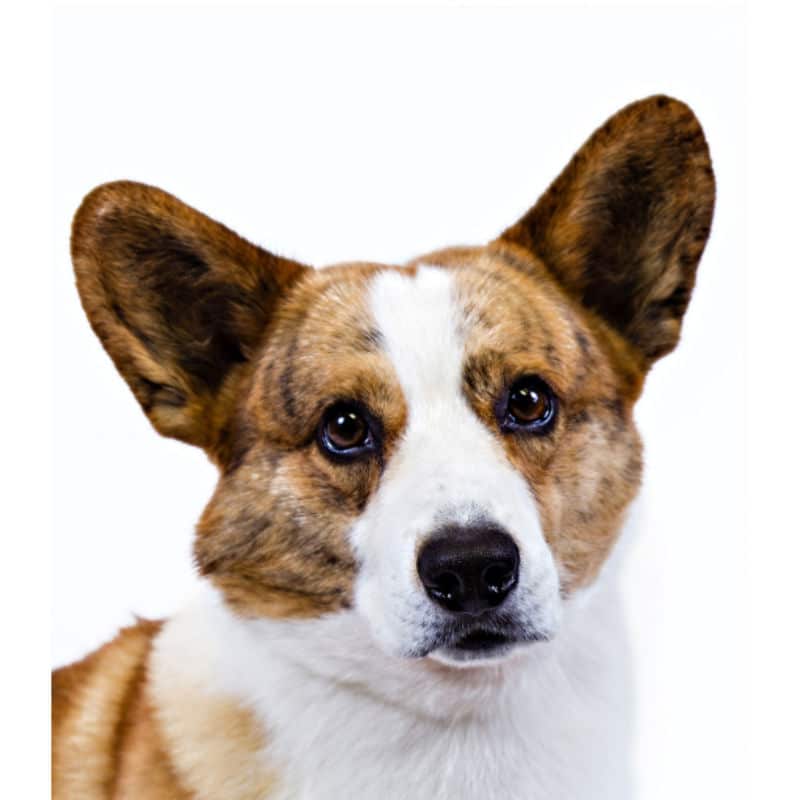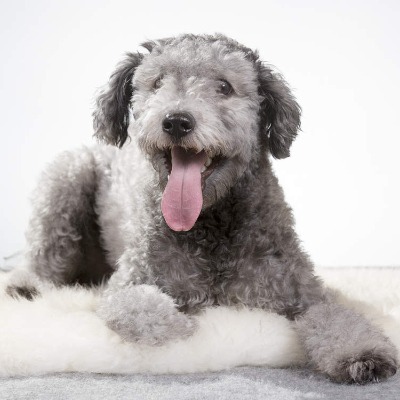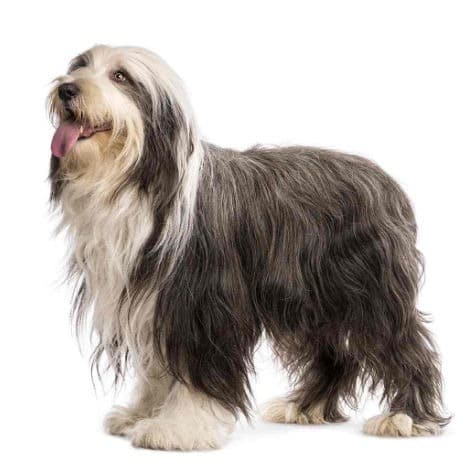Schipperke
Tireless, agile and always ready to attract attention with a long bark
In the Flemish dialect, Schipperke means "little shepherd".The common ancestor of the Belgian Shepherds and the Shipperke would be a shepherd dog, of an ancient breed, generally black and quite small, called "Leuvenaar". Its origin dates back to the 17th century.Around 1690 the Shipperke was the favorite dog of the people of the Brussels people and cobblers of the Saint-Géry district, who organized competitions to show off the chiseled leather collars with which they adorned their dogs.The tail was completely cut off, a fashion that dates back, it seems, to the 15th century. He was known as a hunter of mice, mice, moles and other pests.The Schipperke was first exhibited in 1882, in the city of Spa. It became a fashionable dog thanks to Queen Marie Henriette of Belgium.In 1887 he entered Great Britain and the United States. The first standard was drawn up in 1888 by the club responsible for the breed, founded in the same year, and which is the oldest breed club in Belgium.Over the years it has been necessary to make efforts to unify the type. In ancient times, in fact, there was talk of the varieties of Antwerp, Louvain and Brussels.
-
Head
wolf-shaped, wedge-shaped, but not too elongated and wide enough to be in harmony with the body.
Moderately arched browbones and cheekbones. The transition from the region of the skull to that of the muzzle is visible but must not be too marked.
-
Head - cranial region
Quite a wide forehead, narrowing towards the eyes, slightly rounded when seen in profile. The toplines of the skull and the muzzle are parallel.
Stop: Pronounced but not exaggerated
-
Head - facial region
Nose: Smal1, nose leather always black.
Muzzle: Tapering towards the nose; well-chiselled, not too long, and not truncated; length approximately 40 per cent of the total length of the head; rectilinear foreface.
Lips: Black, close-fitting.
Jaws/Teeth: Healthy, well-set teeth. Scissor bite, pincer bite tolerated. Complete dentition according to the dental formula. The lack of one or two premolars 1 (1PM1 or 2PM1) or of a premolar 2
(1PM2) is tolerated and the molars 3 (M3) are not taken into consideration.
Cheeks: Clean, blending imperceptibly into the sides of the muzzle
Eyes: Dark brown in colour, small, almond-shaped, neither sunken nor protruding; sharp, lively and mischievous look, black-rimmed eyelids.
Ears: Erect, very small, pointed, triangular (as far as possible equilateral), set high but not too close to each other, firm and extremely mobile. -
Neck
Strong, powerfully muscled and appearing very voluminous because of the abundant hair on the ruff, medium length, well-set into shoulders, carried well and higher when dog is alert, upper line being slightly arched.
-
Body
Short and wide, therefore cobby, but not overbulky or heavy, ideally fitting into a square; its length from point of shoulder to point of buttock is roughly equal to height at withers.
Topline: The topline of the back and loin is straight and firm, often rising slightly from croup to withers.
Withers: Very pronounced and seeming even more so because of the mane.
Back: Short, straight and strong.
Loins: Short, broad and powerful.
Croup: Short, broad and horizontal; the rear section of the croup i.e. the junction between the croup and the point of the buttocks is pleasingly rounded, a shape known as a Guinea pig rump.
Chest: Well let down to the elbows; broad in front and also behind the shoulders, therefore having a good spring of rib. In profile the forechest is prominent.
Underline and belly: The underline of the chest well-let down, reaching the elbows, harmoniously and gently rising towards the belly, which has a moderate tuck-up, neither pendulous nor
whippety. -
Tail
Set high. Some dogs are born completely tailless or with a rudimentary or incomplete tail (stumpy or short tail).
They should not be penalized for this. At rest a natural tail (reaching at least to the hock), is preferably hanging down and can be raised when the dog is moving, carried in line with the topline, but preferably not higher.
A curled tail or a tail carried over the back is accepted. -
Limbs
Fine-boned and set well beneath the body -
Forequarters
General appearance: The front legs are upright viewed from all sides and are perfectly parallel when seen from the front; their length from the ground to the elbow equals approximately half the height at the withers.
Shoulders: Long and sloping, normal shoulder angulation.
Upper arm: Long and adequately sloping.
Elbows: Strong, neither turning in nor out.
Forearm: Straight, quite well-set apart when seen from the front.
Carpus (Wrist): Strong and not prominent.
Metacarpus (Pastern): Quite short, seen from the front continuing the line of the forearm, in profile at most very slightly sloping.
Forefeet: Smal1, round and tight (cat feet), arched toes, short, strong nails, always black. -
Hindquarters
General appearance: The hindquarters must be placed under the body and be perfectly parallel when viewed from behind.
Thigh: Long, strongly muscled, seeming even wider than they are because of the thickness of the culotte.
Stifle: Approximately in line with the hip; normal angulations.
Lower thigh: Approximately the same length as the thighs.
Hock joint: Well angulated, without exaggeration.
Metatarsus (Rear Pastern): Rather short; dewclaws not desirable.
Hind feet: Like front feet or marginally longer. -
Gait / Movement
Movement at the trot is supple and firm with a reasonable reach and good rear thrust, the topline remaining horizontal and the limbs moving parallel; the front movement should be in harmony with the rear movement and the elbows must not turn out. At faster speed the limbs converge -
Skin
Tight fitting over the whole body. -
Coat - hair
The top coat is abundant, thick, straight and sufficiently harsh, with quite firm texture, therefore dry and resistant to the touch, forming an excellent protection together with the soft thick undercoat.
Very short hair on the ears, short hair on the head, the front part of the front legs, the hocks and rear pasterns.
On the body, the average length hair is close-lying.
Around the neck the hair is much longer and more off-standing, beginning at the outer edges of
the ears, forming, especial1y in the male but also in the female, a wide and very typical ruff (long hair around the neck, in tufts on each side), a “mane” (long hair on the top of the neck, continuing as far as the withers and the shoulders) and a frill (long hair on the underside of the neck and on the chest, stretching between the forelegs and gradually fading away under the chest).
On the back of the thighs long and abundant hair covering the anal region, with tips angled
inward in a very typical way, form the culottes.
The tail is furnished with hair the same length as that on the body. -
Coat - color
completely black.
The undercoat does not have to be black, but it can be dark gray if it is completely hidden by the top coat.
A little gray, for example on the muzzle, due to age, is accepted.
-
Size and weight
Weight: Between 3 and 9 kg.
An average weight of 4 to 7 kg is sought after.
-
Faults
Any departure from the foregoing points should be considered a fault and the seriousness with which the fault should be regarded should be in exact proportion to its degree and its effect on
the health and welfare of the dog.
• General appearance: Cloddy, lacking substance; too long or too short in leg; long body, fitting into a rectangle.
Head: Too long or too short. Lines of skull and muzzle not parallel, foxy-faced; too prominent brows or cheek bones.
Cranial region: Too narrow, forehead too rounded or domed (apple-headed).
Muzzle: Too long, pinched, thick, truncated, convex topline.
Teeth: Badly aligned or badly set.
Eyes: Large, round or protuberant, light in colour (hazel eyes still acceptable).
• Body:
Chest: Narrow, flat, cylindrical. Not sufficiently let down.
Croup: Long, sloping, raised, break in the roundness of the rump (transition from croup to back of thighs).
• Limbs: Too little or exaggerated angulation.
• Movement: Close-moving, short stride, lacking drive, not keeping correct topline when moving, high stepping front movement, hopping rear movement.
• Coat
Hair: Too short (close to body), too long, too thin, soft or silky, wavy, lying too flat to the body or hanging down; too little or no ruff, mane, frill or culotte (more serious a fault in the male, especially a lack of ruff). Not enough undercoat.
Colour: Grey, brownish or reddish tones in the top coat and occasionally a few white hairs even on the toes.
• Temperament: Apathetic or timid. -
Severe faults
Teeth: Lack of one incisor (1I), of three premolars 1 (3 PM1) or two premolars 2 (2 PM2). -
Disqualifying faults
• Aggressive or overly shy.
• Any dog clearly showing physical or behavioural abnormalities.
• Lack of breed type.
• Over- or undershot jaw, even without loss of contact (reverse scissors bite) wry mouth, lack of one canine (1 C), of one upper carnassial (1PM4) or one lower carnassial (1M1) of one molar (1M1 or 1M2 but not any M3), of one premolar 4 (lower PM4), of one premolar 3 (1PM3) as we1l as another
tooth or in total 4 missing teeth or more (excluding the four premolars 1).
• Lack of pigment on nose, lips and eyelids.
• Ears: Falling or semi-erect.
• Coat which is long, soft or silky, i.e. an obviously “longhaired” type of coat; fringes of long hair on the ears; behind the limbs etc.; total lack of undercoat.
• Colour: Topcoat of any other colour than black (except grey, brownish or reddish tones) or with tiny white spots, even on the toes.
• Weight: Clearly outside the designated limits.
N.B.:
• Male animals should have two apparently normal testicles fully descended into the scrotum.
• Only functionally and clinically healthy dogs, with breed typical conformation should be used for breeding.
The latest amendments are in bold characters.

